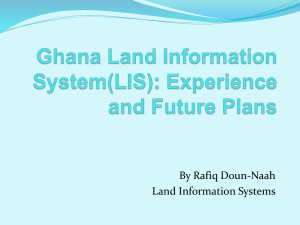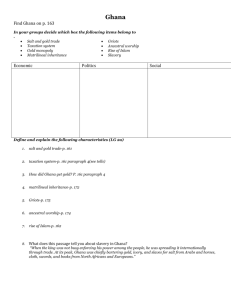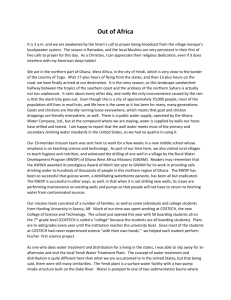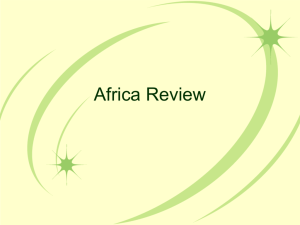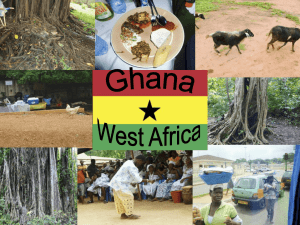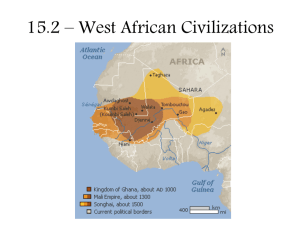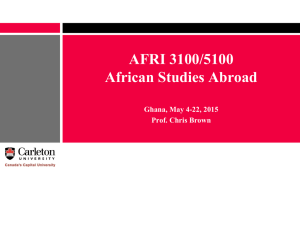THE AFRICAN DEVELOPMENT BANK (ADB)
advertisement
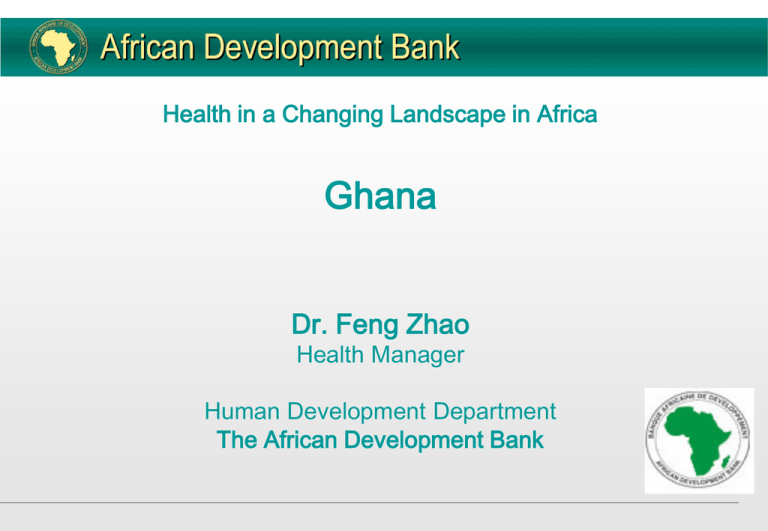
Health in a Changing Landscape in Africa Ghana Dr. Feng Zhao Health Manager Human Development Department The African Development Bank Outline A rapidly changing landscape in Africa An innovative strategy for engaging in health AfDB’s engagement in health in Ghana Plan for next phases Areas of interest Changing Landscape Continued economic growth Population dividend Changing aid dynamics Increased need for value for money and domestic accountability Opportunity for innovative ways of delivering services (e.g. ICT solutions) Guiding documents Medium-Term Strategy Human Development Strategy Focus Area 1. Improve Competitiveness and Employment Opportunities Focus Area 2. Value for Money and Accountability in Service Delivery Focus Area 3. Risk Protection, Inclusion and Social Cohesion Instruments Public sector window Private sector window Lending: Loan/grant Non-lending: Analytical work; TA New strategic thinking on health The Bank has been supporting health since 1970s Traditionally, the Bank focused on health sector infrastructure e.g., hospital construction Shift in Instruments: Stand-alone vs. partnership; focusing on value for money and domestic accountability (Kaberuka’s paper). Shift in focus: Health infrastructure vs. system strengthening Partnership: PPP; alternative financing mechanism (e.g. value for money trust fund) Leadership Demand for African leadership The Bank has recently made strategic HR investments ( for example the hiring of health economists, HRH and health insurance specialists) and is now well positioned to exploit the new opportunities New approach (a). The new approach includes multi-sector operations e.g. health (including nutrition) in agriculture, climate change, water and sanitation; private sector operations such as PPPs for hospital construction and management; provision of essential drugs e.g. for HIV/AIDS; ICT operations in eHealth. New approach (b). The Bank will pursue innovative partnerships to mobilize and leverage resources for the Continent. For example, the Bank is currently discussing a new Multi-donor TF to support value for money and domestic accountability as well as to sustain the coverage of essential HIV services that are affected by the decrease of ODA from the traditional donor community. New approach (c). The Bank will work with RMCs and private sector to revitalize the pharmaceutical industry and make it an engine for economic growth and job creation. In this regard, the Bank is discussing with South Africa to explore the best way of supporting the first ARV production line of the continent. New approach (d). The Bank will also focus on knowledge products in critical areas such as health insurance and eHealth. For example the Bank is currently working on a Continent-wide study of health insurance models which can be applied in Africa. Past support to Ghana ADB is involved in the Health sector in Ghana since 1990 under three Health projects. These projects were focused on health system strengthening. The first ADF intervention in Ghana’s health sector (Health I) was approved in January 1990. It was for a loan amount of UA 13.88 million for the development of two national teaching hospitals, Korle-Bu and Komfo Anokye Hospitals as well as a regional hospital, Effia Nkwanta Hospital. The ADF allocation for Ghana in 1991 was able to finance only three out of the five district hospitals requested for Health II i.e. Yendi, Kibi and Keta District Hospitals. Both projects were successfully completed and Borrower’s Project Completion Reports submitted. The Borrower experienced long delays between project appraisal and commencement of project activities as well as untimely payment of counterpart funds in the implementation of both projects. Previous Bank Group experience in the sector noted weak project management and irregular payment of counterpart funds resulting in delays in project implementation. Current support to Ghana The third project (Health III project) is still ongoing and the disbursement date line is 31st March 2012. The main achievement of the Health III project is the Construction of Tarkwa hospital which is 98% complete and the Bekwai Hospital which is 50% complete. A capacity building component is also part of the project. The Bank is involved in the sectoral dialogue and has participated in the three health summits held annually and the monthly partner meetings. Economic Sector Work In view of the importance the Bank attaches to issues of regional integration and the need to take into account challenges related to access to drugs (ARV, drugs for TB and malaria) in the West African Region a filed visit was undertaken to Ghana from 31 January -4th February 2011 by representatives from Benin, Cote d’Ivoire and Burkina Faso) UNAIDS in collaboration with the Bank facilitated the process of exploring the possibility of establishing a manufacturing industry in West Africa. The study seeks to find out the real and concrete possibility and interest of the Ghana private and public institutions to host an Italian initiative in the field of Pharmaceutical Company. Ghana was part of the countries visited. The main findings of the study showed the need to upgrade Drugs local factories in the country. The main report is under review for the final approval. Discussion will be followed up with the Italian Cooperation for a more in depth analysis of the local production of drug’ sector. Future support The Bank is exploring more PPP activities in the Health sector. The issue of Human resource for health could be address under PPP activities. For 2012 a Health impact assessment in the oil and gas sector is scheduled subject to the availability of funds trough the bilateral funds. The HIA will be a diagnostic study with baseline information to help monitor and measure impact of the oil and gas developments on the target communities. The TOR and proposal are already available. Discussion continues with the Italian Funds to upgrade the drug’s industries in the countries The Bank is involved in the development of the Health financing strategy.



